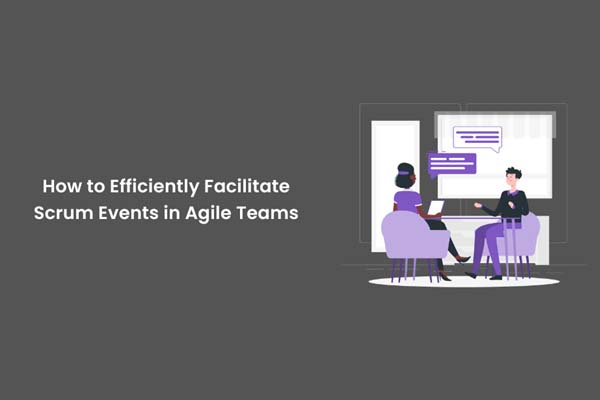Do you Know How to Efficiently Facilitate Scrum Events in Agile Teams? Agile techniques have become extremely popular in the fast-paced world of software development and project management due to their capacity to promote cooperation, adaptation, and continual improvement. Scrum Events, sometimes called ceremonies, are crucial components of the Scrum framework because they allow teams to coordinate, plan, examine, and modify their work. Agile teams must effectively facilitate Scrum events if they want to stay on schedule and produce worthwhile products. Because of this, gaining Scrum Certification is beneficial for giving professionals the information and abilities they need to master the art of Scrum events. We will understand the essential elements of effectively enabling Scrum in this blog.

Understanding Scrum Events
Agile framework Scrum has a focus on incremental and iterative product development. It comprises well-defined roles, artefacts, and events that interact to boost output and produce high-quality goods.
Sprint Planning, Daily Stand-up (Daily Scrum), Sprint Review, and Sprint Retrospective are all examples of Scrum events. These occasions offer crucial chances for teams to organise their tasks, coordinate their efforts, highlight their achievements, and continually improve their procedures.
Efficiently Facilitating Scrum Events
Here are the steps to follow for facilitating scrum events:
- Clear objectives and goals must be established before any Scrum event. Each event’s goal should be clearly stated so that the team is aware of the intended results and can concentrate on obtaining them.
- Scrum events are timeboxed, which means that their length is predetermined. Timeboxing keeps the activities brief and concentrated, preventing them from morphing into drawn-out sessions that accomplish nothing.
- All team members should actively participate in Scrum events, according to facilitators. For effective planning, problem-solving, and decision-making, everyone’s contribution is important.
- Agile teams may self-organise and collaborate through scrum events. Facilitators should encourage team members to take responsibility for their work and come to choices together.
- During Scrum events, the team’s progress may be seen visually using tools like tasks or Scrum boards. Visualising job items enables efficient communication and assists in locating bottlenecks.
- Facilitators should ensure that each Scrum event stays within its timeframe and prevent side trips that can result in time loss.
The Significance of Scrum Certification
The significance of Scrum certification is given below:
- Professionals with a Scrum certification have an in-depth understanding of the Scrum framework, its tenets, and its practices. This information is crucial for successfully conducting Scrum meetings and leading Agile teams to victory.
- The Agile community recognises and values Scrum certification broadly. It shows a professional’s dedication to lifelong learning and development, making them more appealing to prospective employers and customers.
- Training on facilitation methods particular to Scrum events is frequently included in Scrum certification programmes. Certified professionals learn useful abilities to confidently and competently manage and guide Scrum events.
- The credibility of a professional as a Scrum expert is increased through Scrum certification. The advice of a qualified Scrum facilitator is more likely to be trusted by clients, stakeholders, and team members.
- Professionals who have earned a Scrum certification are better prepared to handle problems that may emerge during the execution of Agile projects and Scrum events.
Preparing for Scrum Certification
Steps to prepare for scrum certification:
- Scrum certifications come in various forms, including Certified Scrum Master (CSM) and Professional Scrum Master (PSM). Select the certification that best suits your level of experience and professional objectives.
- Enrol in a renowned Scrum certification programme led by knowledgeable instructors. To improve your comprehension of Scrum events, these courses frequently contain practical exercises and real-world scenarios.
- To acquire confidence and improve your facilitation abilities, practise leading Scrum events in a secure setting, such as a training class or with colleagues.
- To better grasp Scrum events and concepts, familiarise yourself with official Scrum manuals and best practices.
Conclusion
Agile teams must successfully conduct Scrum events if they want to enhance productivity and complete projects on schedule. The Scrum framework provides a disciplined technique for successfully carrying out these operations, ensuring continuous progress and cooperation. Scrum certification may help professionals achieve the skills, qualifications, and recognition they need to succeed in guiding teams through the Agile transformation process and delivering Scrum events. By adopting Scrum ideas and gaining Scrum certification, professionals may become important assets in developing high-performing Agile teams and delivering exceptional products in today’s fast-paced and competitive business environment. Visit Our Site.


